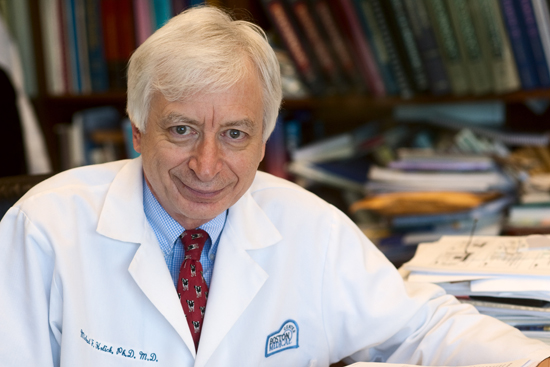Vitamin D Guru to Deliver University Lecture
MED’s Holick will discuss the sunshine nutrient and why we need it

“Vitamin D chose me,” says Michael Holick, who has been an outspoken advocate worldwide for awareness of the ravages of vitamin D deficiency. As tonight’s 2013 University Lecturer, the School of Medicine professor of medicine, physiology, and biophysics will speak about his long career studying what he dubs the “D-Lightful” nutrient and share the story of how he became consumed by a subject he once considered boring.
Director of Boston Medical Center’s Bone Health Care Clinic and of MED’s Vitamin D, Skin and Bone Research Laboratory, Holick is a winner of the Linus Pauling Institute’s Linus Pauling Prize for health research and the author of The Vitamin D Solution: A 3-Step Strategy to Cure Our Most Common Health Problem (Plume, 2011). He believes the world is in the throes of a vitamin D defiency pandemic, which is causing bone disease and osteoporosis in adults as well as increasing the risk of a range of diseases, including some cancers, tuberculosis, influenza, diabetes, stroke, heart disease, and schizophrenia. About a third of all Americans are at risk for vitamin D deficiency, he says, and that the risk is higher for young children. It’s estimated that vitamin D deficiency affects nearly two billion people worldwide, making it, he says, one of the world’s leading medical problems.
Vitamin D regulates insulin production in the pancreas as well as in genes that control cell growth, and it helps the immune system, says Holick, who has been studying how skin makes vitamin D for more than 30 years. “Every tissue and cell has a vitamin D receptor. We estimate that as many as 2,000 genes—up to one-sixth of the total human genome—are directly or indirectly regulated by vitamin D.”
Holick’s zeal for the “sunshine vitamin,” which has earned him some detractors, has its roots in his early research as a resident at Massachusetts General Hospital, which shed light, so to speak, on the elegant way that our bodies synthesize the vitamin in our skin during sun exposure. His research resulted in what he calls “the concept of sensible sun exposure” coexisting with protection from skin cancers and other damage. Recently he worked with a California-based software engineer to develop an app that he says “not only tells you how much Vitamin D you are producing anywhere at any time of the year, but also provides a warning when you’ve made enough Vitamin D and that further sun exposure can increase the risk of skin damage.”
“The major cause of the vitamin D deficiency epidemic is the lack of appreciation that sun exposure has been, and continues to be, the major source of the vitamin worldwide,” says Holick, who in his lecture will elaborate on his three-step strategy to treat and prevent vitamin D deficiency.
The University Lecture was established in 1950 to honor faculty engaged in outstanding research and to offer an opportunity to hear a distinguished scholar discuss a favorite topic. All faculty members are invited each spring to nominate the subsequent year’s lecturer. University Lecturers from the previous five years act as the selection committee.
Michael Holick will give the 2013 University Lecture, titled The D-Lightful Vitamin D for Health, tonight, Wednesday, November 6, at 7 p.m. at the Tsai Performance Center, 685 Commonwealth Ave. Admission is free and open to the public.
This BU Today story was written by Susan Seligson. She can be reached at sueselig@bu.edu.